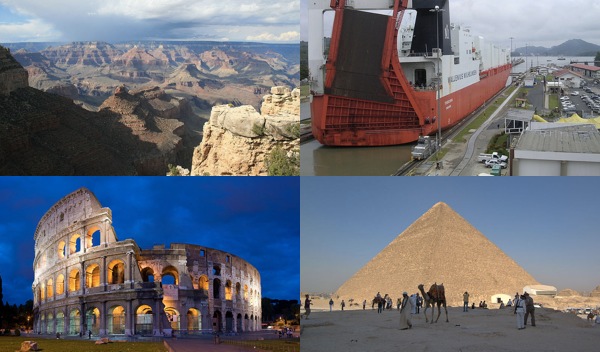Humans love lists. You’ll find them across your Facebook feed, and on numerous blogs, but they’re not new. In fact, one of the oldest lists in existence is that of the Seven Wonders of the World. Dating as far back to Ancient Greece, the original Seven Wonders list includes only sights near the Mediterranean, and only the pyramids have lasted these last 2,400 years. Luckily, there are multiple lists of the seven wonders, all available for you to peruse on this BatchGeo map.
View Seven Wonders of the World in a full screen map
The ancient wonders were apparently used as a sort of guidebook for Greek sightseers. Who knew such a thing existed? They included a temple and mausoleum in modern day Turkey, two statues in what is still called Greece, the Lighthouse of Alexandria (Egypt), Gardens of Babylon (Iraq) and the aforementioned Egyptian pyramids. You can still visit the location, ruins, or replicas of the six that no longer exist in their ancient glory.
The other Seven Wonders lists are more recent and most you are able to visit easily. Many are still clustered in Europe, but every continent except Antarctica is represented. Here are the lists themselves. You can use the grouping tool to choose the type of Wonder from the map above.
- Seven Wonders of the Ancient World
- Seven Civil Wonders of the World
- Seven Medieval Wonders of the World
- New7Wonders Foundation Wonders of the World
- Seven Natural Wonders of the World
- Seven Wonders of the Industrial World
- USA Today’s New Seven Wonders
Two lists have eight wonders. The New7Wonders list added the pyramids as an honorary candidate after controversy over the ancient wonder competing with 20 other finalists. USA Today’s New Seven Wonders added a viewer-chosen eighth wonder after the seven judge-chosen wonders were announced on Good Morning America. Viewers selected the Grand Canyon.

Arizona’s sprawling landmark is one of a handful of wonders that make multiple lists. Grand Canyon is on the USA Today’s New Seven Wonders, as well as Wonders of the Natural World. The Great Wall of China and the Colosseum both make the Medieval and New7Wonders lists. The Panama Canal gets the nod for Civil and Industrial Wonders. The pyramids, of course, are an original Wonder, in addition to being on the New7Wonders list.
The farthest from continental land is Papahānaumokuākea Marine National Monument. It also could lay claim to being the largest wonder, at over 140,000 square miles. It dwarfs the Grand Canyon, for example. However, not all Wonders can be measured in square miles. The Great Wall of China is 13,000 miles long.
There are a few Wonders that are difficult to map. Aurora is a naturally occurring phenomenon that causes beautiful light displays in the sky. That it occurs in the sky makes it difficult to map. On top of that, it typically is viewed at high latitude, but not any particular location. The Polar Ice Cap is at 90 degrees latitude and simultaneously at every longitude, making it easier to identify on a globe than a flat map. Lastly, USA Today’s Seven Wonders list included the Internet, which is not physical at all. However, since you’re reading this from the Internet, why don’t we all agree it’s well represented on the interactive map above.

